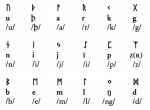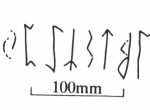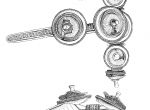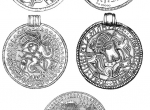Runes/ runic alphabet
Runes/runic alphabet, a writing system evolved in south Scandinavia used in recording texts in Germanic languages →Germanic Tribes . Individual characters are a combination of vertical and oblique strokes, usually executed by carving in a hard material like stone, metal, wood or antler. The runic script is known as futhark, from its first six letters. The earliest reliable finds of runic inscriptions date to mid-2nd century AD. Runes were in use in Northern Europe until the 15th c. The earliest system, elder futhark, consisted of 24 letters (fig. 1.), the younger form, depending on the region, had a different number of characters. Most inscriptions in elder futhark go back to 200-700 AD. Its younger form is dated to around 800-1500 AD. Most runic inscriptions have been discovered in Scandinavia, and a smaller number – from today’s Netherlands and Germany (south-eastern North Sea coast in particular). A handful of inscriptions in elder futhark is recorded in other areas of Central Europe. During the Viking period (ca. 800-1050 AD.) runic script spread also to other regions. Objects with inscriptions in futhark are known from areas as far apart as Greenland and Iceland and today’s Russia, between Staraya Ladoga and the Dnieper.
Individual characters of futhark represent more than just the phonemes; starting from the 4th c. they also symbolize specific ideas. Depending on their context the runic inscriptions, mostly very short, served different functions: as a signature of the maker of an object, signature of an object’s owner, they could have a magic significance, commemorate a dead individual or record the name of the object on which they were inscribed (http://www.schloss-gottorf.de/zbsa/aktuelles/nachrichten-2013/News/die-aelteste-schrift-mitteldeutschlands). Runic inscriptions have appeared on different categories of object, most frequently, on runestones (fig. 2.) that commemorate an individual or an event, on dress accessories (fig. 3.), weapons, →Scandinavian Bracteat (fig. 4.) and on everyday objects. In Poland they have been observed on finds from Pomerania and northern Greater Poland, in →Migration Period deposits containing gold bracteats (such as →Karlino , →Wapno , →Zagorzyn , →Suchań ).
Currently there is a number of views on the origins of futhark; its prototypes are thought to be one of the following: a) Latin alphabet (the most frequently presented view); b) Greek alphabet; c) southern Alpine alphabets or d) Phoenician/Punic alphabet. And there is also an alternative theory that runic alphabets were a fully indigenous development in the region where the earliest confirmed inscriptions are recorded.
MP
Literature: K. Düwel, S. Nowak (eds), Runeninschriften als Quellen interdisziplinären Forschung. Abhandlungen des Vierten Internationalen Symposiums über Runen und Runeninschriften in Göttingen von 4.-9. August 1995, [in:] Reallexikon der germanischen Altertumskunde, Ergänzungsband 15, Berlin-New York 1998; P. Ethelberg Skovgårde. Ein Bestattungsplatz mit reichen Frauengräbern des 3.Jhr. n.Chr. auf Seeland, Nordiske Fortidsminder, Ser. B, 19, Copenhagen 2000; Runenschrift, [in:] H. Beck et all. (eds.) Reallexikon der germanischen Altertumskunde, vol. 25, Berlin-New York 2003, p. 571-585 (K. Düwel); K. Düwel, Runenkunde, [in:] H. Beck, H. Jankuhn et all. (eds.) Reallexikon der germanischen Altertumskunde, Weimar 2008; K. Düwel, Altes und Neues zur Entstehung der Runenschrift, Die Kunde, N.F. 61, 2010, p. 229-258; Reichmann Ch., Zur Entstehung der Runen, [in:] B. Ludowici, H. Pöppelmann (eds.), Das Miteinander, Nebeneinander und Gegeneinander von Kulturen. Zur Archäologie und Geschichte wechselseitiger Beziehungen im 1. Jahrtausend n. Chr., Neue Studien zur Sachsenforschung, 2, Hannover 2011, p. 18-50.
-
 full resolution
full resolution
Fig. 1. Transliteration of runic characters (K. Düwel 2008).
-
 full resolution
full resolution
Fig. 2. Futhark on the Kylver Stone, Gotland, one of the few inscriptions with a sequential listing of the runes of the elder futhark (K. Düwel 2008).
-
 full resolution
full resolution
Fig. 3. Late Roman Period rosette brooch from Skovgårde, Zealand, with a runic inscription on the catchplate (P. Ethelberg 2000).
-
 full resolution
full resolution
Fig. 4. Bracteats with runic inscriptions (K. Düwel 2008).


